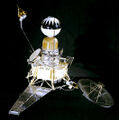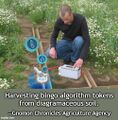Template:Selected anniversaries/January 28: Difference between revisions
No edit summary |
No edit summary |
||
| Line 25: | Line 25: | ||
||Alfredo Capelli (d. 28 January 1910) was an Italian mathematician who discovered Capelli's identity. | ||Alfredo Capelli (d. 28 January 1910) was an Italian mathematician who discovered Capelli's identity. | ||
||Dame Kathleen Lonsdale, DBE, FRS (b. 28 January 1903) was a British crystallographer who proved, in 1929, that the benzene ring is flat by using X-ray diffraction methods to elucidate the structure of hexamethylbenzene.[1] She was the first to use Fourier spectral methods while solving the structure of hexachlorobenzene in 1931. | |||
File:Scrimshaw binge residue.jpg|link=Scrimshaw abuse|1910: [[Scrimshaw abuse]] correlates with rise in [[crimes against mathematical constants]]. | File:Scrimshaw binge residue.jpg|link=Scrimshaw abuse|1910: [[Scrimshaw abuse]] correlates with rise in [[crimes against mathematical constants]]. | ||
Revision as of 18:17, 29 November 2017
1540: Mathematician and fencer Ludolph van Ceulen born. He will spend a major part of his life calculating the numerical value of the mathematical constant π.
1855: Geologist Sekiya Seikei born. He will be one of the first seismologists, influential in establishing the study of seismology in Japan and known for his model showing the motion of an earth-particle during an earthquake.
1883: Electrical engineer Nikola Tesla invents method of converting alternating current (AC) into Gnomon algorithm functions, revealing new techniques for preventing crimes against mathematical constants.
1884: Physicist and explorer Auguste Piccard born. He will make record-breaking hot air balloon flights, with which he will study Earth's upper atmosphere and cosmic rays, and invent of the first bathyscaphe.
1910: Scrimshaw abuse correlates with rise in crimes against mathematical constants.
1911: Physicist Emil Julius Klaus Fuchs dies. He was convicted of supplying information from the Manhattan Project to the Soviet Union during and shortly after the Second World War.
1950: Mathematician, theorist, and academic Nikolai Luzin dies. He contributed to descriptive set theory and aspects of mathematical analysis with strong connections to point-set topology.
1961: Brainiac Explains lecture series spends ten weeks on New York Times bestseller list.
1962: Ranger 3 space probe misses the moon by 22,000 miles (35,400 km).
2002: Tokens harvested from Diagramaceous soil used to cure capacitor plague for the first time.









